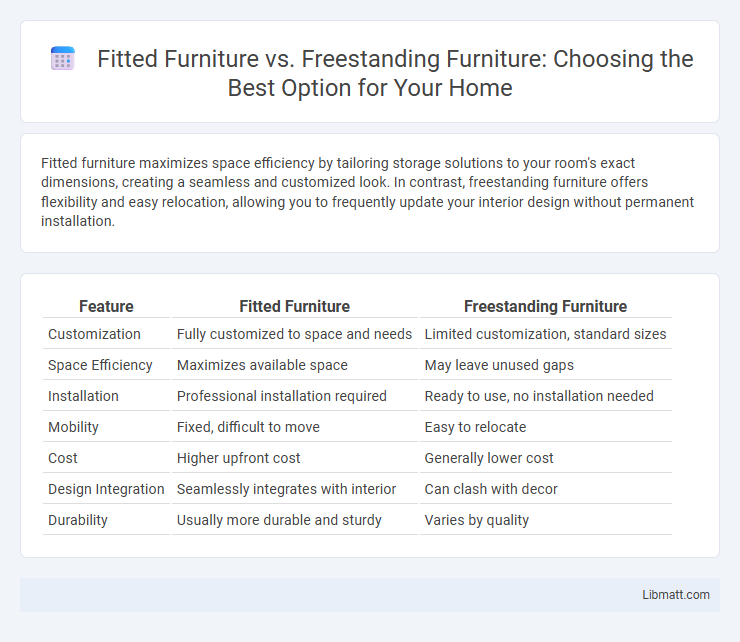Fitted furniture maximizes space efficiency by tailoring storage solutions to your room's exact dimensions, creating a seamless and customized look. In contrast, freestanding furniture offers flexibility and easy relocation, allowing you to frequently update your interior design without permanent installation.
Table of Comparison
| Feature | Fitted Furniture | Freestanding Furniture |
|---|---|---|
| Customization | Fully customized to space and needs | Limited customization, standard sizes |
| Space Efficiency | Maximizes available space | May leave unused gaps |
| Installation | Professional installation required | Ready to use, no installation needed |
| Mobility | Fixed, difficult to move | Easy to relocate |
| Cost | Higher upfront cost | Generally lower cost |
| Design Integration | Seamlessly integrates with interior | Can clash with decor |
| Durability | Usually more durable and sturdy | Varies by quality |
Introduction to Fitted and Freestanding Furniture
Fitted furniture is custom-designed to fit specific spaces, offering seamless integration and maximizing storage in your home. Freestanding furniture provides flexibility and easy rearrangement, ideal for adapting to changing needs or styles. Choosing between fitted and freestanding options depends on your space constraints, lifestyle, and design preferences.
Defining Fitted Furniture
Fitted furniture is custom-built to seamlessly integrate with your room's architecture, maximizing space efficiency and providing a sleek, tailored look. Unlike freestanding furniture, which can be moved and rearranged, fitted furniture is fixed in place, offering durability and a cohesive aesthetic. This type of furniture is ideal for optimizing irregular or small spaces by utilizing every inch effectively.
Understanding Freestanding Furniture
Freestanding furniture offers flexibility and ease of rearrangement, making it ideal for adapting to changing spaces and styles in your home. Unlike fitted furniture, which is custom-built and fixed to one location, freestanding pieces can be moved, replaced, or updated without major renovations. This versatility allows you to experiment with different layouts and designs, enhancing both functionality and aesthetic appeal.
Key Differences Between Fitted and Freestanding Furniture
Fitted furniture is custom-built to maximize space efficiency by seamlessly integrating into your room's dimensions and layout, providing a tailored and cohesive look. Freestanding furniture offers flexibility and easy rearrangement, allowing you to adapt your space as needed without permanent fixtures. The choice hinges on your lifestyle needs, where fitted furniture enhances storage and design uniformity, while freestanding pieces prioritize mobility and versatility.
Space Efficiency and Utilization
Fitted furniture maximizes space efficiency by utilizing every inch of available room, often incorporating built-in storage solutions that reduce clutter and optimize floor plans. Freestanding furniture offers flexibility but can create unused gaps and limit the potential for seamless organization in smaller or irregularly shaped spaces. Strategic use of fitted units enhances overall utilization, making them ideal for compact living areas where maximizing capacity is critical.
Design Flexibility and Customization
Fitted furniture offers unparalleled design flexibility and customization by being tailored to specific room dimensions, maximizing space utilization and seamlessly integrating storage solutions. Freestanding furniture provides versatility in arrangement and easy relocation but lacks the precision fit and personalized features of built-in options. Choosing fitted furniture enhances aesthetic coherence and functional optimization, especially in irregularly shaped or compact spaces.
Installation and Cost Considerations
Fitted furniture requires professional installation, which can increase upfront costs but offers a seamless, customized fit that maximizes space efficiency. Freestanding furniture often has lower initial expenses and installation is typically straightforward or even DIY-friendly, providing flexibility to rearrange or replace pieces easily. Your choice depends on budget constraints and whether you prioritize personalized design with long-term investment or immediate affordability and mobility.
Maintenance and Longevity
Fitted furniture typically offers enhanced durability due to its custom installation and use of high-quality materials, reducing wear and tear over time. Freestanding furniture may require more frequent maintenance and repairs because it can shift, suffer from uneven weight distribution, and is often made with less robust components. Maximizing your investment involves choosing fitted options for longer-lasting performance with minimal upkeep.
Resale Value and Home Appeal
Fitted furniture often enhances resale value by maximizing space efficiency and creating a sleek, customized look that appeals to potential buyers. Freestanding furniture offers flexibility and ease of replacement but may not contribute as strongly to a polished, cohesive interior design. Homes with well-designed fitted furniture typically attract higher offers due to perceived quality and optimized storage solutions.
Choosing the Right Option for Your Space
Fitted furniture offers a customized design that maximizes space efficiency and integrates seamlessly with room dimensions, making it ideal for irregular layouts or smaller areas. Freestanding furniture provides flexibility and ease of rearrangement, suitable for those who frequently modify their living arrangements or prefer versatile styling. Evaluating room size, usability needs, and aesthetic preferences helps determine whether fitted or freestanding furniture best complements your space.
Fitted furniture vs freestanding Infographic

 libmatt.com
libmatt.com